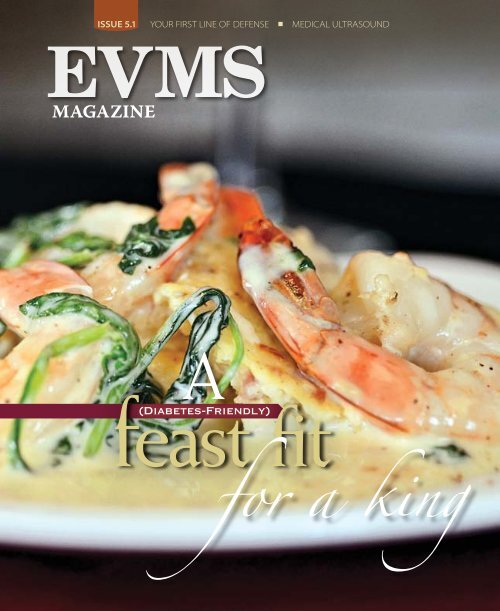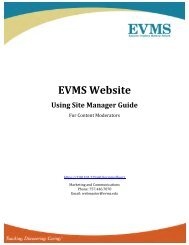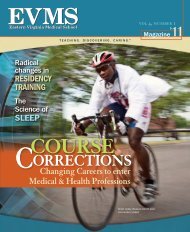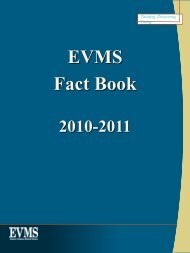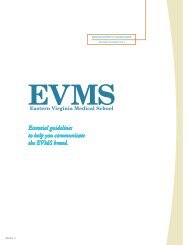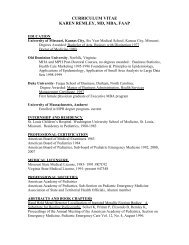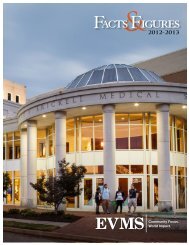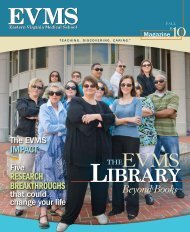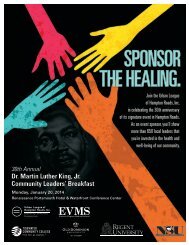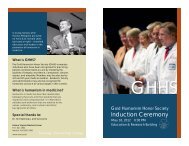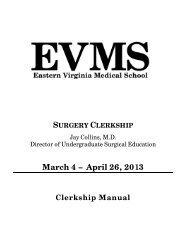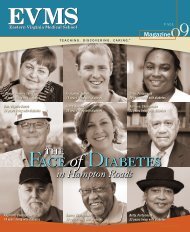Fall 2012 - Eastern Virginia Medical School
Fall 2012 - Eastern Virginia Medical School
Fall 2012 - Eastern Virginia Medical School
Create successful ePaper yourself
Turn your PDF publications into a flip-book with our unique Google optimized e-Paper software.
VisitOctober 13-28www.homearama.tvWe thankthe communityand L.R. HillCustom Buildersfor supportingthe EVMS Fund.We’re healthierbecauseyou’re here.At its core, EVMS exists andthrives because of one thing:community. We’re here becausethe people in this region neededbetter access to health care,and we strive every day to meetHampton Roads’ growing needsby teaching new physicians andhealth professionals, pushingthe scientific envelope in ourlabs and providing high-qualitycare to more than 1,000 patientsevery day.The EVMSHealthyHouseBuilt by L.R. Hill Custom BuildersSupporting the EVMS Fund
ISSUE 5.1magazineupcomingeventsOctober 13-28<strong>Fall</strong> <strong>2012</strong> HomearamaMake plans to visit the EVMSHealthy House at this year'sfall Homearama event atEast Beach in Norfolk. Tourthe home and take part in avariety of healthy activities.Visit www.Homearama.TV.November 17Diabetes AwarenessNight with the NorfolkAdmiralsEnjoy a night of fast-pacedaction and show yoursupport for the StrelitzDiabetes Center at EVMSduring the second annualnight of hockey at theNorfolk Scope. Diabetes staffwill be on hand to offer freediabetes screenings. Ticketsare only $11 each; a portionof ticket sales benefit EVMSdiabetes research. To reserveyour tickets, visit www.evms.edu/admirals.November 29EVMS Strelitz DiabetesCenter OpeningCelebrate the opening ofthe newly renovated centerthat offers cutting-edge caresupported by research andpatient education. Tour thenew space and interact withscientists and physicians.For more information, visitwww.evms.edu/magazine.EVMS staffs the only Level 1 trauma center inthe region.featuresEating healthy doesn’t mean suffering througha dull diet.<strong>Medical</strong> ultrasound comes of age.16 Your first line of defenseWhen life hangs in the balance, the EVMS surgeons staffing Sentara NorfolkGeneral Hospital's Level 1 trauma center, answer the call 24 hours a day, 365days a year.22 A (diabetes friendly) feast fit for a kingEating healthy doesn't have to mean sacrificing taste. Executive Chef EdwardStorey of Bardo Edibles + Elixirs and Dietician Phyllis Woodson of the EVMSStrelitz Diabetes Center, prepare a meal so delectable, you'll forget that its goodfor you, too.30 Is the stethoscope about to become extinct?EVMS is taking a leadership role in advancing the everyday useof ultrasound and preparing the health-care workforce of tomorrow to takeadvantage of this increasing portable and affordable technology.EVMS Magazine Issue 5.1 www.evms.edu 3
Our Vision: <strong>Eastern</strong> <strong>Virginia</strong> <strong>Medical</strong> <strong>School</strong> will be recognized asthe most community-oriented medical school in the nation.magazineISSUE 5.16 8 10 12 34 43departments6 Vital StatsThe EVMS Jones Institute7 News + NotesPresident Lester named region’s First Citizen EVMS and William& Mary to explore possible merger Richard Zweifler, MD,appointed Chair of Neurology Board elects first female rectorCONRAD makes leadership change Student outreach headsto Haiti EVMS and Anthem Foundation team to battle diabetesNew student orientation EVMS enjoys $3.5 million boost instate support Graduates to carry on EVMS’ community-orientedmission ‘Top Docs’ Grant comes just in time for surge in newHIV patients WHRO honors Otolaryngology Chair EVMSphysician-scientist garners grant to study polio vaccines Fridaythe 13th Student group wins award Employers honored withBIB awards EVMS partners with JDRF Book reviews34 Alumni ConnectionsEVMS alum assumes command of USNS Comfort’s <strong>Medical</strong>Treatment Facility EVMS grad serves veterans in WashingtonFollowing the family path to medicine Class notes32 Your SupportCapital Campaign draws strong support ahead of year-end finaleCompassion a driving force for Glennan Center benefactor<strong>2012</strong> EVMS Fund supports key needs across campus Localfamily supports diabetes research41 Your HealthHelping you breathe easier42 In FocusPresidentHarry T. LesterProvost and DeanRichard V. Homan, MDSenior Vice President & Chief of StaffClaudia E. KeenanEDITORSVincent RhodesEditor-in-Chief,Director of Marketing & CommunicationsBlair BarbieriAccount ExecutiveLinda CobbCopy EditorDoug GardnerNews DirectorDaniel ShumanAssistant Director of Marketing& CommunicationsGraphic designJohn Comerford, Joy EllinorArt DirectorsVickie Carper, Tamara Potter,Cammi MosimanGraphic DesignersEDITORIAL BOARDMelissa LangDirector of Alumni RelationsConnie McKenzieDirector of DevelopmentMarsha JenningsDirector of Health Services MarketingJustin Crutchfield, Natalie SemmlerOffice of Marketing & CommunicationsSerena Amerson, Denise Cohan,Megan Christopher, Ashley Gentry, Dena ListonOffice of DevelopmentCONTRIBUTORSJennifer FrancisAlison JohnsonLauren KeimLaura Neff-HendersonAlex StraussJoy VannEVMS Magazine is published three times a year. Copies are availableon campus, in doctors’ offices and by mail. To request a copy or sharenews, please contact Doug Gardner, News Director, 757.446.7070 ornews@evms.edu.follow usFACEBOOKwww.facebook.com EVMSeduTWITTERwww.twitter.com/EVMSeduFlickrwww.flickr.com/evmsYou tubewww.youtube.com/<strong>Eastern</strong>VaMed<strong>School</strong>RSSfeeds.feedburner.com/evms4 EVMS Magazine Issue 5.1 www.evms.edu
fromthePresidentIn 1973, community leaders celebrated the establishment of EVMSas an example of regional cooperation at its best. Cities throughoutSoutheastern <strong>Virginia</strong> supported the effort and backed it up withmunicipal contributions.Fast-forward nearly 40 years. EVMS once again is the focus of a region-widediscussion. The issue now is whether EVMS should become the William & Mary HealthSciences University.This is an exciting prospect, but not something to venture into lightly. The Boards ateach school have agreed to entertain the question, and we have begun our due diligence.At this point, we don’t know how long the evaluation process will take. Any merger wouldneed the approval of the legislature and the Governor. Stay tuned.As we examine our institutional affiliations, our faculty are busy with some keyeducational and clinical priorities.For instance, one group of scientists and physicians are preparing our students for theworkplace of tomorrow. See why ultrasound may render the stethoscope obsolete (page30).Another group of faculty provide the type of indispensable care that our founders musthave hoped for. Go to page 16 to learn how EVMS trauma surgeons save lives daily in acooperative venture with Sentara Healthcare.Finally, we asked the staff at Norfolk restaurant Bardo Edibles + Elixirs to come upwith some diabetes-friendly fare for the holidays. Executive Chef Edward Storey workedwith EVMS nutritionist Phyllis Woodson to develop the dishes, starting on page 22, thatyou can prepare for yourself.You may have noticed a new look for our magazine with this issue. What hasn’tchanged is our commitment to sharing compelling stories and exciting news about ourschool of medicine and health professions. I hope you enjoy both the content and the newdesign.As always, thank you for your interest in and support of EVMS.Sincerely,Harry T. LesterEVMS BOARD OF VISITORSAnne B. ShumadineRectorP. Ward RobinettVice RectorDavid A. AriasI.A. Barot, MDFrank Batten, Jr.Derwin P. Gray, MDEva Teig HardyJames J. Izard, IIDavid T. LawsonChristina W. Prillaman, MDRobin D. RayKenneth W. StolleBruce L. ThompsonMark R. WardenTheresa W. Whibley, MDRichard C. ZoreticEVMS FOUNDATION BOARD OF TRUSTEESG. Robert Aston, Jr.Chairman and PresidentVincent J. Mastracco, Jr., Esq.TreasurerAndrew S. FineSecretaryR. Bruce BradleyL.D. Britt, MD, MPHCharles P. Fletcher, DDSThe Honorable Paul D. FraimThomas R. Frantz, Esq.Richard S. Glasser, Esq.Robert C. Goodman, Jr., Esq.Edward L. Hamm, Jr.Paul O. Hirschbiel, Jr.B. Thomas MansbachCharles W. MoormanPriscilla Trinder RoadyThomas V. RuegerToy D. Savage, Jr., Esq.Alan L. Wagner, MDStanley WaranchWayne F. WilbanksEVMS Magazine Issue 5.1 www.evms.edu 5
vitalstatsThe EVMS Jones Institute recently celebrated its 4,000 IVF birth. It takes a lotof time, energy and money to raise just one baby. Imagine raising all 4,000!$1.2 million spent onbaby food the first year.$28 million spent onbaby items like toys andclothes in the first year.Considering the trend inpopular names, if you wroteout all 4,000 names,odds are that Emily,Madison, Hannah, Jacob,Michael and Joshua woulddominate the list.5.6 million hours of lostsleep can be credited to those4,000 little bundles of joy.A total of 29.2 milliondiaper changes made by theOn average, it takes twoage of 2.minutes per diaper changefor a total of three 40-hourwork weeks for just one child.That’s a total of 24,00040-hour work weeks for all ofthe babies.These fun factsMore than 2 million mileswalked with babies in strollers— nearly five trips to themoon and back!Some 488,000 hoursspent reading to newborns.On average, 1.3 millionloads of laundry or 21.2million articles of clothingwashed per year.were compiled fromhttp://www.happyworker.com/supermom/factsandhttp://thestir.cafemom.com/baby/6339/Babys_First_Year_Broken_Down6 EVMS Magazine Issue 5.1 www.evms.edu
news+notesPresident Lesternamed region’sFirst CitizenEVMS President Harry T. Lesteris the <strong>2012</strong> First Citizen of HamptonRoads.President Lester was honored June21 at the annual awards ceremonysponsored by LEAD Hampton Roads,a program of the Hampton RoadsChamber of Commerce.TowneBank President and EVMSBoard of Trustees Chairman RobertAston introduced Mr. Lester, depictinghim as a humble leader with anincredible ability to inspire others toachieve great things.The bank Chairman and CEOpraised Mr. Lester for serving as acatalyst for positive change and forgingcollaborations and strong relationshipsacross organizational and geographicalboundaries.“His successful efforts to secure astrong financial footing for EVMS andthe Chrysler Museum, in particular,have made it possible for two ofHampton Roads’ great institutionsto both thrive and create innovativeand sustainable initiatives for a bright<strong>Eastern</strong> <strong>Virginia</strong> <strong>Medical</strong> <strong>School</strong> President Harry T. Lester in theEdward E. Brickell <strong>Medical</strong> Sciences Library rotunda.future,” Mr. Aston says.Mr. Lester began his affiliation withEVMS in 2003 as a member of theBoard of Visitors. He became Presidentin 2005.EVMS and William & Mary to explore possible mergerThe College of William & Mary and <strong>Eastern</strong> <strong>Virginia</strong><strong>Medical</strong> <strong>School</strong> announced in July that they have agreed toexclusively explore the feasibility of having EVMS become theWilliam & Mary Health Sciences University. Before a decisioncan be made by either W&M or EVMS, each must carefullyinvestigate the implications of such a combination.The Board of Visitors has directed that EVMS performdue diligence in this regard, and it is not yet clear how longthis process will take. If W&M and EVMS decide to proceed,approval from the Governor and General Assembly will berequired.President Harry T. Lester says, “The fact that one of theoldest, most prestigious colleges in the country would consideraffiliating with us speaks volumes about the groundbreakingwork our faculty, staff and students are achieving every day.While we won’t know for some time how this will work out,I think this is a tremendous compliment and an opportunityworth exploring.”FOLLOW OUR TWITTER FEED www.twitter.com/EVMSedu for news and links to everything EVMS.EVMS Magazine Issue 5.1 www.evms.edu 7
news+notesRichard Zweifler appointedChair of NeurologyRichard M. Zweifler, MD, has beenappointed Chair of Neurology, effectiveAugust 1. Dr. Zweifler succeeds Thomas R.Pellegrino, MD, who held the post until hisdeath in November 2011.“Dr. Zweiflerhas an outstandingreputation and iswell-respected byhis peers andcolleagues,” saysProvost and DeanRichard V. Homan,MD. Dr. Zweiflercurrently serves asChief of NeurologyRichard M. Zweifler, MD for SentaraHealthcare andhas been a Professor of Neurology at EVMSsince 2008.Dr. Zweifler received his MD fromTulane <strong>Medical</strong> <strong>School</strong> and completedresidency training in neurology and afellowship in cerebrovascular disease at theUniversity of California in San Diego. He isboard certified in neurology and vascularneurology and holds specialty certificationsin neurosonology and neurosonologyexamination.He joined EVMS after serving as Professorand Director of the Stroke Center at theUniversity of South Alabama. He serves onthe Editorial Board of Frontiers in Stroke andas reviewer for journals including Neurology,Stroke and Headache.In addition to his membership in AlphaOmega Alpha, the honor society for medicine,Dr. Zweifler has authored more than 80book chapters, manuscripts, abstracts andpeer-reviewed publications. He has activelyparticipated in 20 National Institutes ofHealth-funded research studies and receivedmore than $3 million in external fundingfor research in stroke and cerebrovasculardiseases.Anne B. ShumadineBoard elects first female rectorin school’s historyAnne B. Shumadine has been elected Rector of the EVMSBoard of Visitors, making her the first female to lead the boardin the institution’s history.She was selected for the position in June in a unanimous vote followingthe resignation of Maurice A. Jones. Mr. Jones resigned from the board dueto his confirmation as Deputy Secretary of the U.S. Department of Housingand Urban Development.“There are many great, forward-looking leaders in our community, fromall genders, races, religions and backgrounds, and I am confident I won’tbe the last ‘first’ for this institution,” Mrs. Shumadine says. “EVMS isprogressive and enlightened, and being rector is a privilege that I don’t takelightly.”Mrs. Shumadine will help lead the medical school as it grows its studentbody and faculty to tackle a growing national shortage of doctors and8 EVMS Magazine Issue 5.1 www.evms.edu
news+noteschanges mandated by federal and statehealth care reforms.“We must be nimble and ready toaddress those changes and preparefor the influx of new patients into oursystem,” she says. “With the greatwork that President Harry Lester hasdone over the past eight years, and theexperience and expertise that our newDean Richard Homan brings to thecampus, we are poised to take EVMSto the next level.”The Board will be working with theDean to re-think the curriculum toprepare a robust learning experiencethat incorporates the new way patientswill experience health care, she says.Mrs. Shumadine is a graduate ofWellesley College and the Marshall-Wythe <strong>School</strong> of Law at the Collegeof William & Mary and is Chairmanand a Founder of Signature FinancialServices in Norfolk.She serves on the Board ofthe Chesapeake Bay Foundationand is a Trustee and Chair of theinvestment committee at <strong>Virginia</strong>Wesleyan College. Mrs. Shumadine’spast associations include a formerRectorship on the Board of Visitorsof Old Dominion University, whereshe is currently a member of the ODUEducational Foundation. She is alsoformer President and Chairman ofthe Board of the ACCESS CollegeFoundation, a former Trustee of theChrysler Museum of Art, and a pastmember of the Business LeadershipCouncil of Wellesley College.In 2011, Mrs. Shumadine receivedthe Citizen Lawyer award from theWilliam & Mary <strong>School</strong> of Law, wasthe recipient of the Barron F. BlackCommunity Builder Award fromthe Hampton Roads CommunityFoundation and was recognizedby LEAD Hampton Roads with itsVisionary Award for business leaders.Dr. Doncel chosen to lead CONRADGustavo F. Doncel, MD, PhD, formerly Scientific and Associate Director ofCONRAD, has been chosen to lead the internationally known program at EVMS. Hebegan his new role as Executive Director Aug. 1.Dr. Doncel follows Henry L. Gabelnick, PhD, one of the original CONRAD staffmembers and head of the organization for more than 20 years. Dr. Gabelnick is nowa Senior Advisor to CONRAD. CONRAD facilitates the development of productsand methods to prevent conception and to halt the spread of sexually transmitteddiseases, in particular HIV/AIDS.“Dr. Doncel is an internationally renowned,academic clinical scientist who has mademajor contributions to scientific research,especially in the field of reproductive healthand HIV/AIDS prevention,” says AlfredZ. Abuhamad, MD, Professor and Chairof Obstetrics and Gynecology. CONRADis a program of the EVMS Department ofObstetrics and Gynecology.Dr. Doncel joined the EVMS Departmentof Obstetrics and Gynecology in 1990. Withhis pioneering work on microbicides — whichprotect women against sexually transmitteddiseases — and sperm function inhibitors, Dr.Doncel laid the foundation for CONRAD’sGustavo F. Doncel, MD, PhDexpansion into HIV and multipurpose prevention technologies.Dr. Doncel is an accomplished researcher with skills that span basic and clinicalscience. He is currently the principal and co-principal investigator of grants totalingmore than $138 million.He is a reviewer for the U.S. National Institutes of Health and the EuropeanCommission Directorate General for Research and Innovation, and an expert advisorto the World Health Organization. He is also a member of scientific advisory boardsof several national and international research organizations. Dr. Doncel received theDean’s Faculty Achievement Award from EVMS in 2009 and is the author of morethan 100 peer-reviewed scientific publications and several U.S. and internationalpatents on antimicrobial contraceptives and microbicides.CONRAD was established in 1986 with federal funding from the U.S. Agency forInternational Development. Originally focused solely on contraceptive development,CONRAD grew under Dr. Gabelnick’s direction to include an emphasis on diseaseprevention.Dr. Gabelnick also broadened support for CONRAD to include funds from privatefoundations. All told, CONRAD has attracted more than $400 million from publicand private sources.Dr. Gabelnick earned his undergraduate and master’s degrees at the MassachusettsInstitute of Technology and a PhD in chemical engineering at Princeton. He spent 18years with the National Institutes of Health before joining CONRAD.“Under Dr. Gabelnick’s leadership, CONRAD played a leading role in improvingreproductive health for women around the globe,” Dr. Abuhamad says.EVMS Magazine Issue 5.1 www.evms.edu 9
news+notesMatt Balderston,MD Class of 2013,enjoys time with anew friend duringa medical missionearlier this year tothe Maison Fortuneorphanage inHinche, Haiti.Student outreach heads to HaitiJames Coulter,MD Class of 2013,prepares to examinea young patient atthe orphanage.For EVMS students, medicine is about so muchmore than books and laboratories. It’s about makinga difference in the lives of people in the community.Every day, students demonstrate that having ameaningful impact on the world is more than just aschool mission — it’s a practiced belief at the very coreofwhat makes EVMS unique. InHampton Roads and beyond,EVMS students are involvedin outreach projects thatstrive to improve the healthof a global community. The<strong>2012</strong> trip to Haiti was onesuch important endeavor.EVMS students traveledto Haiti in March to providemedical care to one of thepoorest countries in theworld. They also delivered 15 water filtrationsystems capable of filtering more than 60,000 gallonsof dirty water — equivalent to the volume of 500,000water bottles. These machines are a vital lifeline in aplace where clean water is a luxury and where manypeople have died of cholera.“It was so much more stimulating, in every way,than I could have imagined,” says Ryan Barnette, MDTerri W. Babineau, MD, Director of Community Outreach for EVMS,has helped to forge a bond with the Haitian orphanage. EVMSstudents visit Haiti on a regular basis.Class of 2013. “I can say that being open to feel that,to reflect on that raw emotion, is a gift far more thananything I could ever have hoped to give the Haitianpeople.”Mr. Barnett and his fellow classmates spent timeat an orphanage that is home to more than 200children, 140 of whom were displaced by the recentearthquake. They also visited a hospital in Hincheand saw medicine at practice in a place with noaccess to running water.“I was incredibly fortunate to be able to go toHaiti,” says Tolga Sursal, MD Class of 2015. “It wasmy first experience with international medicine andI was excited to finally live out some of the things Ihad only read about in books.”Get more information on this and other important studentoutreach projects by visiting www.evms.edu/magazine.10 EVMS Magazine Issue 5.1 www.evms.edu
news+notesAnthem Blue Cross Blue Shieldteams with EVMS to battle diabetesEVMS is collaborating with the Anthem Blue Cross Blue ShieldFoundation in a project intended to reduce the prevalence ofdiabetes in adults in Southeastern <strong>Virginia</strong> and to diminish thenumbers of deaths attributable to the disease.As part of a year-long $203,000Anthem Blue Cross Blue Shield grant,the EVMS Strelitz Diabetes Centeris working with patients and localphysicians to lessen the impact of thedisease. The region has the highestmortality rate for diabetes in <strong>Virginia</strong>,nearly twice the state average.“Hampton Roads is an epicenterin <strong>Virginia</strong> for obesity and theaccompanying problems of diabetesand heart disease,” says Joseph A. Aloi,MD, Clinical Director of the StrelitzDiabetes Center and Program Directorfor the grant. “We are grateful to theAnthem Foundation for recognizingthe scope of the problem and forpartnering with us to work toward asolution.”“We are pleased to be able towork with EVMS to target diabetesin Southeastern <strong>Virginia</strong>,” says JaySchukman, MD, Anthem’s Chief<strong>Medical</strong> Director. “By identifyingpeople at high risk for diabetes orhelping catch this disease in anearly stage, we can help folks putplans in place to help combat it fromdeveloping further.”With support from Anthem, theStrelitz Diabetes Center co-hostsdiabetes screenings at physicianoffices, workplaces and communityevents across the region to locatepeople with an undiagnosed diseaseand those in the early stage ofdeveloping the disease, a conditionknown as pre-diabetes. Dr. Aloisays the goal is to perform 2,000screenings over the span of the oneyeargrant.Once people with the disease orthose who are at-risk are identified,Strelitz Diabetes Center specialistswork with community physiciansto develop follow-up care plans.That may include medical therapyor assistance in adopting lifestylechanges, such as halting smoking,lowering blood pressure or losingweight.The project is unusual in that italso provides continuing medicaleducation for community physiciansand recruits peer counselors —patients who have successfullymanaged their diseases — to helpothers.WellPoint Inc. and AnthemInc. merged in 2004 to form oneof America’s premier health carecompanies. Anthem Blue Cross andBlue Shield has a history of strongsupport for EVMS. The AnthemProfessorship in Cancer Researchsupports the Leroy T. Canoles Jr.Cancer Research Center at EVMS.The Anthem Blue Cross and BlueShield Foundation, a private, nonprofitorganization wholly fundedby WellPoint, Inc., also has fundedimmunization initiatives through theProject Immunize <strong>Virginia</strong> programat EVMS.EVMS Magazine Issue 5.1 www.evms.edu 11
news+notesFaculty and guestspeaker Daniel M.Becker, MD, MPH,Director of the Centerfor Biomedical Ethicsand Humanities at theUniversity of <strong>Virginia</strong>,congratulate medicalstudents during theWhite Coat ceremony.Dr. Becker delivered theannual H. Lee KanterLecture.New Student OrientationIn August, EVMS rolled out thewelcome mat to 284 new students during abusy orientation week. This annual rite ofpassage for all incoming students, kickedoff with the Dean’s Breakfast. There, thestudents mixed and mingled with theirnew classmates and met with faculty andschool leaders. Students received their IDs,class schedules and just about everythingelse they’ll need for a successful tenureat EVMS. Students attended workshops,hosted by faculty and staff, and learnedabout what the school has to offer. Then itwas off to the President’s Picnic to indulgein some BBQ, sweet tea and snow cones.In addition to eating, students and theirfamilies and friends could partake in agame of cornhole or strike a pose in thealways-popular photo booth. The weekconcluded with 145 MD students receivingtheir white coats during the traditionalceremony in front of faculty, family andfriends at Harrison Opera House.Friends, from left, Oluvoniyin Peters, Barron Frasier, Laura Tyrell and Mike Murphy enjoy the President’s Picnic.Provost and Dean Richard V. Homan, MD, visits withstudents at the President’s Picnic on the lawn atSmith-Rogers Hall.<strong>Medical</strong> students Ibrahim Abubakar, left, and BrandenDeyerele, center, talk with Master of Public Health studentBrook Alemu on the first morning of orientation.VISIT www.flickr.com/photos/evms to view more photos from this and other EVMS events.12 EVMS Magazine Issue 5.1 www.evms.edu
news+notesEVMS enjoys $3.5 millionboost in state supportThe <strong>Virginia</strong> General Assembly onceagain has increased its annual allotmentto EVMS to support the school’seducational mission.The latest boost came in the form of$3.5 million in additional funding forFiscal Year 2013. EVMS receives $16million of support for education, as wellas another $8 million in state money forindigent care, family-practice funding,medical modeling and simulation andfinancial aid for students.Historically, EVMS has beenconsiderably underfunded compared tothe other medical schools in <strong>Virginia</strong>.President Harry T. Lester has workeddiligently with state officials to buildrecognition for the school’s work and tomake up the funding shortfall.“Governor McDonnell and thelegislature appreciate the school’simportance to the health of the regionand the state,” President Lester says. “Weare grateful for their continued support.”Much of the new funding will gotoward adding faculty for a growingstudent class. Following the openinglast fall of a new education and researchbuilding, the school is boostingenrollment to help prepare morephysicians, physician assistants andother health care professionals in theface of an expected nationwide shortageof health care workers.The additional state support also ishelping EVMS hold the line on tuitionincreases. This year’s increaseswere the lowest inmore than20 years.<strong>Virginia</strong> Capitol, Richmond Va.Graduates to carry on EVMS’ communityorientedmissionDoctors Without Borders U.S. BoardPresident Matthew C. Spitzer, MD, reveledin the community-oriented environmentand mission of EVMS as he spoke tograduates May 19 at the Norfolk Scope.“Since I arrived yesterday, I have feltlike I am almost among comrades — alliesin a certain struggle,” Dr. Spitzer, keynotespeaker for commencement, said to the296 graduates and thousands of familyand friends.Dr. Spitzer encouraged the studentsto adopt the tenets of the founders ofDoctors Without Borders: to combineconcrete medical action with individualconscience. He spelled out the threeconcepts that help guide his organization’svolunteers during their work — to be onthe front lines to witness the need forcare, refusing to accept unacceptablesituations involving patients, and drivingfor innovation — illustrating each with astory from his travels and work around theworld to assist the less fortunate.“Humanitarian medicine, orcommunity-oriented health care, is notsomething we should think of as charitycare or where something is better thannothing,” he said. “Instead, it shouldseek the highest standards and the bestcare possible, whether very far away in adeveloping country or next door.”Newly commissioned Army Captain Josiah L.Wrensford looks on as loved ones pin on his rankat the military commissioning ceremony on theBattleship Wisconsin.Commencement-related ceremoniesbegan with what has quickly become anew EVMS tradition: the White CoatRetirement Ceremony. <strong>Medical</strong> studentsand friends returned to WindhavenFarm in Windsor to retire their shortwhite coats in preparation for the longwhite coats worn by physicians.The festivities included the annualmilitary commissioning ceremonyaboard the USS Wisconsin in downtownNorfolk and the physician assistantprogram’s White Coat and AwardsCeremony. There also were a seriesof banquets and receptions to honorgraduates, including a new ceremonythis year to induct students and facultyinto the Gold Humanism Honor Society.EVMS Magazine Issue 5.1 www.evms.edu 13
news+notesEVMS physiciansare ’Top Docs’EVMS is wellrepresented in thisyear’s Top Docs listthat appears in theSeptember issueof Hampton RoadsMagazine.The magazine honors some 250EVMS full-time and community facultyphysicians and alumni. That’s morethan half of the 440 doctors who wereselected by peers to be part of the annuallist. The list includes 37 physicians whopractice with EVMS Health Services.Go to evms.edu/magazine for acomplete list of the honorees.Grant comes just in time forsurge in new HIV patientsEVMS has received critical, longtermfederal funding to care foruninsured HIV patients.The additional $900,000 spreadover three years will be used to carefor HIV patients unable to afford theirtreatment, says Edward C. Oldfield,MD, Director of the EVMS Center forthe Comprehensive Care of ImmuneDeficiency (C3ID). EVMS physicianssee the majority of low-income HIVpatients in Southeastern <strong>Virginia</strong> andthe <strong>Eastern</strong> Shore.The money, from the Ryan WhiteHIV/AIDS Program, comes just in time.While the number of C3ID Ryan Whitepatients has mushroomed 250 percentsince 2007, funding has grown just 12percent. And the volume of new patientscontinues to soar.C3ID instituted a series of costsavingmeasures to stretch the limitedfederal funding, reducing the annualcost of care per person (excludingmedications) from $2,319 to $1,530.WHRO Honors Otolaryngology Chairwith Community Impact AwardBarry Strasnick, MD, Professor and Chairof Otolaryngology-Head and Neck Surgery,was awarded the <strong>2012</strong> WHRO CommunityImpact Award in the area of Health andPublic Safety.The category recognizes those whoseefforts raise community awareness aboutsafety issues and help protect the public, orwhose individual acts of heroism save lives.Dr. Strasnick was nominated for his workwith the Coalition for Hearing, Educationand Research (CHEAR).He also was recently named as a <strong>2012</strong> BestDoctor in <strong>Virginia</strong> Living Magazine and waslisted among one of the “Top Doctors” inBarry Strasnick, MDOtolaryngology by U.S. News and World Report.EVMS physician-scientist garners grant to study polio vaccinesAn EVMS infectious disease specialist is receiving research supportfrom a private foundation in her efforts to improve global health.Stephanie B. Troy, MD, is one of 16 physician-scientists selected to receive the <strong>2012</strong>Clinical Scientist Development Award from the Doris Duke Charitable Foundation.Dr. Troy will use the $484,000 award to further her study of the possible risks of poliovaccines and methods to improve them.“Although the current polio vaccines have succeeded in decreasing the number ofglobal polio cases from 600,000 per year to only 650 cases in 2011, they have limitationsthat might make global polio eradication difficult,” says Dr. Troy, who holds jointappointments in the Department of Internal Medicine and in the Department ofMicrobiology and Molecular Cell Biology.The grant will fund a clinical trial investigating whether an injection into the skinrather than the muscle will improve vaccine effectiveness and allow for a reduced doseof inactivated polio vaccine in HIV-infected adults. The reduced dosage, if effective,would make the vaccine more affordable for developing countries, Dr. Troy says.Friday the 13th: a typical day in the ERBruce Lo, MD, Assistant Professor of Emergency Medicine at EVMS, has debunkedthe myth that people are more likely to end up in the ER on Friday the 13th. Dr. Lopublished a study in the July edition of the American Journal of Emergency Medicine.In the study, Dr. Lo compared emergency room visits at six different hospitals over aseven-year period, and determined that average ER visits for Friday the 13th were notincreased compared with the Friday before and after, and the month before.Dr. Lo also evaluated 13 different conditions and determined that only penetratingtraumas were seen more often on Friday the 13th.14 EVMS Magazine Issue 5.1 www.evms.edu
news+notesStudent group working withlocal seniors wins awardBeyond Clinic Walls, a student-runcommunity outreach program, recentlyplaced second and won a $2,000 awardfrom the Commonwealth Council onAging as part of its annual Best Practicesaward competition.The Commonwealth Council onAging advises the governor on issuesaffecting the nearly one million<strong>Virginia</strong>ns age 65 and older.Beyond Clinic Walls pairs EVMSstudent volunteers with older residentsin the Norfolk area who face complexmedical and social issues. The studentsreceive guidance and support fromthe Glennan Center for Geriatrics andGerontology. Clients are recruitedfrom Senior Services of Southeastern<strong>Virginia</strong>, the region’s Area Agency onAging.Beyond Clinic Walls was created byMD Class of 2013 students Daniel C.Parker, Melanie J. Schriber and Sara W.Siddiqui. Each played a pivotal role instarting the program and then passedthe torch to this year’s student leaders,Stephanie M. Lape and Viann N.Nguyen.Learn more about Beyond Clinic Walls byvisiting www.evms.edu/magazine.EVMS partners with JDRFto tackle Type 1 diabetesThe EVMS Strelitz Diabetes Centeris partnering with the Juvenile DiabetesResearch Foundation (JDRF) on a pairof important grants that target Type 1diabetes.The first, a two-year, $500,000grant, will focus on the enzyme12-lipoxygenase (12-LO), an importantlink in the development of Type 1diabetes.Studies in mice show that whenscientists delete the gene responsiblefor 12-LO, mice who are predisposedto develop Type 1 diabetes remain freeof the disease, say co-investigatorsJerry L. Nadler, MD, and David Taylor-Fishwick, PhD.Because deleting genes is not anoption in humans, the researcherswill evaluate a series of potentialnew medications to block 12-LOactivity. The goal is to develop an oralmedication that could serve as the basisfor a similar approach in humans.In the second grant, the EVMSscientists are taking part in a JDRFcollaborative initiative known asnPOD-V (Network for PancreaticDonors with Diabetes) that willinvestigate if a virus triggers theinsulin-cell destruction that leads toType 1 diabetes.The dual research projects couldhave profound implications. Eachyear, more than 13,000 young peopleare diagnosed with Type 1 diabetes,according to the U.S. Centers forDisease Control and Prevention.Employers honored with Business Investment in Babies awardsEVMS was among 17 employers in the region honored in August by the Consortiumfor Infant and Child Health (CINCH) for their efforts to support breastfeeding mothersin the workplace. CINCH, a regional child health coalition sponsored by EVMS,presented the Business Investment in Babies (BIB) Awards during a ceremony August 3.The school now has five “nursing nooks” scattered around campus.BOOK REVIEWS:Alfred Z. Abuhamad,MD, Professor andChair of Obstetrics andGynecology; James C.Lukban, DO, Professorof Obstetrics andGynecology; and KhaledSakhel, MD, AssistantProfessor of Obstetrics and Gynecology,recently wrote a book titled PracticalGuide to Office Procedures in Gynecologyand Urogynecology.“The book serves as an allencompassing manuscript of the officeprocedures performed by gynecologists,”says Dr. Sakel. “It is the only book of itskind currently available on the market.”Unique in its focus on office-basedprocedures, the book thoroughlycovers the essentials of diagnostic andtherapeutic procedures, which are partof the office practice of the women’sspecialist.L. D. Britt, MD, MPH,Henry Ford Professorand Brickhouse Chair ofSurgery, has publishedhis third textbook.Titled Acute CareSurgery, the 64-chapterbook highlights topics such as cuttingedgesurgical technology, managementparadigms, trauma, critical care andemergency general surgery. It alsoprovides guidance on evidence-basedcare for acutely ill surgical patients.Also, Dr. Britt recently was selectedto serve as the lecturer for the Dr. JohnJ. Krueger Annual Lectureship event inNovember in <strong>Virginia</strong> Beach. In its 14thyear, the Krueger Lectureship is namedin honor of a pathologist and leader inboth the medical and lay communities.Dr. Krueger was a strong proponent ofhigh-quality medicine and was involvedin many charities.EVMS Magazine Issue 5.1 www.evms.edu 15
Members of the EVMS traumateam, that provides lifesaving carefor the entire region, include (fromleft to right): Scott F. Reed, MD; JayN. Collins, MD; Leonard J. Weireter,MD; Timothy J. Novosel, MD Classof 2000; and L.D. Britt, MD, MPH.16 EVMS Magazine Issue 5.1 www.evms.edu
Your first line of defenseEVMS staffs the only Level 1trauma center in the regionPink ripples of skin draw lines along Steve Joyner’s facefrom his sparkling blue eyes down cheek bones and to hischin. His hands, too, have soft ridges of puckered skin, thetelling signs of a fiery blaze that nearly took his life.EVMS Magazine Issue 5.1 www.evms.edu 17
Around Christmas in 2011, Mr. Joyner attempted to restart afire using gasoline, something he admits knowing could bedangerous. A sudden reigniting engulfed him in flames.Mr. Joyner suffered third-degree burns on nearly 50 percent of hisbody. He fell in and out of consciousness as paramedics rushed himto the only place in Hampton Roads equipped to provide the carehe needed — the Level 1 trauma center at Sentara Norfolk GeneralHospital (SNGH), which is staffed around the clock by EVMS surgeons.This is high-pressure, rapid-fire medical care, and these men andwomen are your first line of defense. They take the hardest cases — theones where life hangs in the balance, the ones other hospitals aren’tequipped to handle.“You can take care of the majority of injuries in any emergency room,but the trauma center exists for the 15 percent of the worst injuries outthere because you have a finite period of time to do something positive,”says Leonard J. Weireter, MD, Chief of the EVMS Division of Trauma,the Arthur and Marie Kirk Chair and Professor of Surgery. “To get theright patient to the right hospital in the right time frame, that’s whywe are here.”At its core, trauma care is different because it is not a single, specificcondition or area of the body. Trauma is the result of serious or criticalinjuries caused by incidents, such as automobile crashes, falls or actsof violence.Trauma is time sensitive. If you don’t get the right treatment inthe right amount of time, your body will cross a line from whichthere is no turning back. When emergency responders arrive, no oneknows where you are on that line or how long you may have. Thatinitial timeframe is called the “golden hour” — the small window ofopportunity to perform the necessary, life-saving interventions thatgive patients the chance to survive and thrive after traumatic injuries.The SNGH/EVMS team is one of only five Level I trauma centers inthe state and the only one serving the greater Hampton Roads region.That recognition is awarded to hospitals that demonstrate their abilityto provide the highest quality of care for all injured patients. As averified trauma center, SNGH is staffed 24 hours a day, 365 days a yearby EVMS surgeons. They handle cases from Williamsburg to the OuterBanks, provide trauma care for the Navy and take all pediatric traumacases for children of all ages.18 EVMS Magazine Issue 5.1 www.evms.edu
“You can take care of the majority of injuries inany emergency room, but the trauma centerexists for the 15 percent of the worst injuriesout there because you have a finite period oftime to do something positive.”Leonard J. Weireter, MD, Chief of theEVMS Division of TraumaThe team has dedicated emergency-room space capable of handlingmass casualties and round-the-clock access to laboratory and radiologyservices. They have an operating room they can walk into immediatelyand subspecialties, including orthopedic surgery, neurosurgery, plasticsurgery and anesthesiology, waiting for their call. The Trauma Service alsooversees a specific intensive care and burn unit for these patients. Thisteam plays a leading role in every aspect of a patient’s recovery.This is where the fight to beat the clock happens.“We mobilize resources immediately as needed, but that’s what ittakes. That is the institutional commitment this level of care requires,”Dr. Weireter says. “This is an excellent working relationship betweenEVMS and Sentara. They own the hard assets, and we have a leadershipresponsibility to set the medical tone and bring the expertise of a medicalschool to the table.”The numbers tell the story.According to the <strong>Virginia</strong> Department of Health, one in every 350people in <strong>Virginia</strong> will be affected by trauma each year. Plus, trauma isthe leading cause of death for people ages 1 to 44.In 2011, Dr. Weireter’s team saw 2,668 trauma patients. About 240were burn victims like Mr. Joyner. The great majority, however, werevictims of motor-vehicle crashes.Patients like 15-year-old Meaghan Gerety.A slight girl with a pixie hair cut and a wide, toothy smile, Meaghanis a teenager on the mend. Bickering with her dad over typical girllikes-boy-that-parents-don’tscenarios is a welcome occurrence and areminder of how far she has come in just one year.On June 16, 2011, Sean and Tracey Gerety received the 4 a.m. phonecall every parent dreads. Meaghan was involved in a car accident lessthan a mile from their home. She suffered major head trauma, andparamedics weren’t certain she would survive the transport to thehospital.The Gerety’s were told to prepare for the worst.“We were trying to make sense of it all, but they told us that shewould have the best chance of making it if they took her to NorfolkGeneral,” Tracey Gerety says. “We prayed the EVMS surgeons wouldbe able to help her.”At the trauma center, doctors and nurses waited in a cleared traumaEVMS Magazine Issue 5.1 www.evms.edu 19
ay. Snapping into action when Meaghanarrived, the team assessed vital signs andchecked the extent of her skull fracture. Withinthree minutes, she was swept into surgerywhere a portion of her skull was removed toease swelling on the right side of her brain. Herinjuries left Meaghan in a coma for 14 days inthe ICU.The only thing that made Meaghan’s comabearable, her mother says, was the traumateam’s commitment to involving the familyin their loved one’s care. They invite familymembers to participate in ICU rounds, to listento the discussion and to ask questions afterdoctors and residents are finished talking shop.“Words cannot describe what a parent goesthrough to see your child there hooked up tomachines, everything just drains out of you,”Mrs. Gerety says. “The trauma team was sounderstanding and patient and always answeredour questions. There was just this sense thatwe are working together as a team to help mydaughter.”After less than a year, Meaghan returnedto school and started regaining a sense ofnormalcy in her life. It’s been a long road torecovery, but her family has remained focusedon her future.Before his daughter’s accident, Sean Geretydidn’t know about EVMS or the trauma center.Today, he considers himself one of their biggestfans. “If it weren’t for EVMS, my daughterwouldn’t be here, it’s that simple,” he says.In many ways, the trauma team is made up ofunsung heroes.Most people in the community don’tknow what it means to have a Level 1trauma center in their community until theyor loved ones need its services, says L.D. Britt,MD, Brickhouse Chair of Surgery, Henry FordProfessor and a long-time member of the traumateam. Even fewer understand the intricate roleEVMS plays in making that center a reality inHampton Roads.“There are places around the country wherepeople who are critically ill or injured don’t haveaccess to this level of care, but fortunately, wehave it here in Hampton Roads,” Dr. Britt says.“People take it for granted. Get injured, though,and you won’t take it for granted.”When Dr. Britt came to EVMS in 1986, the20 EVMS Magazine Issue 5.1 www.evms.edu
trauma program was not fully developed.He and other EVMS surgeons were on callevery other night until the department builtup a full-time faculty to serve as the surgicalresource at the hospital, says Dr. Britt, whowas Chief of the Trauma Service prior to hisappointment as Department Chair.Today, five core surgeons make upthe trauma team, but the entire surgerydepartment handles trauma calls andworks with residents and fellows. They alsoprovide acute-care surgery services andhave developed an accredited critical-carefellowship with a 100-percent exam pass rate.Having a medical school affiliated with thetrauma center means patients are providedaccess to the newest treatments and thebrightest minds, Dr. Britt says. “You don’thave one person; you have a team of allthese minds determining what is the bestmanagement for your care, and that makesall the difference in the world,” he says. Itcertainly made all the difference to Mr. Joyner.He’s back at work and beginning to do many ofthe things he enjoyed before his accident.“The skills of the surgeons, theirencouragement and the support they gaveme, it all helped me get through this,” Mr.Joyner says. “I walked out of that hospitalthree months after my accident — that’s atestament to just how phenomenal they are.”See SteveJoyner’s story atwww.evms.edu/MyStoryHear more aboutMeaghan’s story atwww.evms.edu/MyStoryEVMS Magazine Issue 5.1 www.evms.edu 21
Afeast(Diabetes-Friendly)fitfor a22 EVMS Magazine Issue 5.1 www.evms.edu
kingexecutive Chef Edward Storey hasworked at Bardo Edibles + Elixersfor the past four years, and as achef for many years before. Heconfesses that dining out can be difficultfor someone trying to watch his or herdiet. But Chef Storey was willing to strayfrom his usual fare in the name of eatinghealthy. Growing up in Georgia, heindulged in his fair share of down-home,southern cooking. However, after hisfather suffered several heart attacks andhis mother learned she has celiac disease,he learned the importance of a proper diet.Watch Chef Edward Storey prepare thisdish and check out the recipe online atEVMS.edu/magazine.EVMS Magazine Issue 5.1 www.evms.edu 23
24 EVMS Magazine Issue 5.1 www.evms.edu
Shrimpwith spinacheating healthy doesn’t mean suffering through a dull diet. Livingwith diabetes or not, we dare you not to relish in the explosion offlavor packed into each bite. Take this mouth-watering entree forexample — sautéed shrimp with spinach, red peppers and pine nutsover a country ham grit cake — that first envelops you in a scent of nutty,fresh seafood. By calling on his southern roots when pairing this ham gritcake with the shrimp, Bardo Edibles + Elixirs Executive Chef Edward Storeycreates an unconventional holiday dish that is still sure to be a crowdpleaser.To make this entree healthier while still keeping all of the flavors, ChefStorey uses olive oil in lieu of butter, substitutes two of the four eggs withegg whites, uses low fat cheese and whipping cream instead of heavy cream.Dietician Phyllis Woodson of EVMS Strelitz Diabetes Center says reducingsugar, fat and salt or sodium intake is good for everyone since thesenutrients in excess can increase your health risks.Find this recipe and more tips for eating healthier,online at EVMS.edu/magazine.EVMS Magazine Issue 5.1 www.evms.edu 25
Carrotcasseroleplated to perfection, Chef Storey’s carrot casserole bursts notonly with color but also flavor. The simplicity of this recipemakes it a snap to prepare at home and a few extra brightorange carrots grated on top go a long way to make this plateas visually appealing as it tastes.Ms. Woodson suggests limiting starches when choosing a sidedish, so Chef Storey turned to a recipe that’s been featured on the menuseverywhere he’s worked: his grandmother’s carrot casserole recipe. But byusing the low fat versions of cheese and mayonnaise, he was able to make awholesome side dish, and make his vegan grandmother proud at the sametime, he says.Like what you see? Visit evms.edu/magazine for this recipe and more.Plus, check out our expert tips for making your favorite meals healthier.26 EVMS Magazine Issue 5.1 www.evms.edu
EVMS Magazine Issue 5.1 www.evms.edu 27
28 EVMS Magazine Issue 5.1 www.evms.edu
Wait, there’s more. Head over to evms.edu/magazine for the recipes of the mealfeatured here, plus two bonus dishes: Turkey Casserole and Almond Broccoli Sauté.Watch as Chef Storey prepares the savory broccoli side and read more tips from Ms.Woodson for preparing healthy meals.Mochameringue kisseswho says you can’t have your cake and eat it too? Solong as its prepared like Chef Storey’s delicate mochameringue kisses, you can. He uses egg whites and a sugarsubstitute so that these bite-sized beauties still satisfy anychocolate lover’s craving, but without all the guilt of indulging in the typicalhigh fat/high calorie dessert. Adding a dollop of fat free whipped cream isthe perfect accompaniment.Since most people tend to overindulge when they’re eating out, Ms.Woodson suggests skipping the appetizer, splitting the entree with someoneor taking half of it home. Avoid dessert, she says, or share it among severalpeople. She also recommends limiting the alcoholic beverages.But wait, there’s more online. To try all of these recipes in your ownkitchen, visit evms.edu/magazine. You’ll also find Chef Storey preparing abonus dish — almond broccoli sauté and the recipe for his turkey casserole.Plus, Ms. Woodson has some more tips for healthy eating. You don’t want tomiss this exclusive online content.EVMS Magazine Issue 5.1 www.evms.edu 29
Is the stethoscopeabout to become extinct?30 EVMS Magazine Issue 5.1 www.evms.edu
A national leader in the effort toexpand the use of medical ultrasound,Alfred Z. Abuhamad, MD, comparesa full-size ultrasound machine with ahand-held unit.<strong>Medical</strong> ULTRASOUNDcomes of age.At 54 years old, Pete thought he was in the best shape ofhis life. But a sudden pain down his left arm and shortnessof breath forced him to dial 911. Within five minutes, aparamedic was using a handheld ultrasound to get acloser look at Pete’s heart.That iconic image of a doctor with a stethoscope may soonbecome a distant memory, as more and more, ultrasoundbecomes the go-to technology of choice for healthprofessionals around the globe. Seventy years afteran Austrian doctor first used it as a diagnostic tool,ultrasound is finally coming of age.Touted as the “stethoscope of the future”for its ability to provide real-time diagnosticinformation, ultrasound’s increasing portabilityand affordability are making it more practical andfeasible than ever. The American <strong>Medical</strong> Association(AMA) has even acknowledged the trend, recently affirmingfor the first time that “ultrasound imaging is a safe, effective and efficient toolwhen utilized by, or under the direction of, appropriately trained physicians.”EVMS Magazine Issue 5.1 www.evms.edu 31
Alfred Z. Abuhamad, MD, Professor and Chair of Obstetricsand Gynecology (Mason C. Andrews Chair), and a long-timeultrasound pioneer, says the AMA resolution is a major stepforward for a technology whose potential is only now beingrealized.“Ultrasound has some important advantages over otherimaging tools,” says Dr. Abuhamad, who also is national presidentof the American Institute of Ultrasound in Medicine, a sponsorof the AMA resolution. “From a safety perspective, ultrasounduses no ionizing radiation, so it is safer. From a cost perspective,it is less expensive than MRI (magnetic resonance imaging) orCT (computed tomography). And from a clinical perspective, itis at least as effective as other imaging modalities in many cases.”Dr. Abuhamad is helping lead the charge to encourage practitionersand payers to consider ultrasound before other diagnostic tools inappropriate situations. “There are gaps in knowledge of ultrasoundon the health-care team,” he says. “As a society, we are trying to fillthose gaps and help the medical community understand the manysituations in which using ultrasound first may be of value.”A Brief HistoryThe roots of ultrasound technology can be traced to ancientGreece, where Pythagoras developed a “sonometer” for measuringmusical sounds.By World War I, the French were building a device capable ofdetecting submerged enemy submarines, the precursor to modernsonar. But it was not until the 1940s that Austrian neurologistKarl Dussik became the first physician to use super-fast soundwaves in medical diagnosis.“I would say that we are still in the infancy of introducing thewidespread use of ultrasound in clinical practice,” says Barry J.Knapp, MD, Associate Professor and Emergency UltrasoundFellowship Director. “Until recently, the scope and focus have beenvery narrow. But in the hands of more physicians, ultrasound isgoing to be an even more powerful tool.”Multiple ApplicationsMost people realize that ultrasound canbe used to get a better look at the heart andbabies in the womb. But EVMS Critical CareSpecialist and Professor of Internal Medicine,Alexander B. Levitov, MD, says fewunderstand the true scope of ultrasound’spotential.“Ultrasound technology is virtuallyomnipotent in that it can be used for everydisease process, with the exception of a fewpsychological disorders,” says Dr. Levitov, who has written twobooks on the subject. Dr. Levitov says ultrasound’s versatility,safety, portability and affordability have helped bring it to suchremote locales as the Mt. Everest base camp, the battlefieldsof the Middle East and the space station. As units becomeeven more portable and cost-effective, ultrasound is alsobecoming ubiquitous in hospitals, clinics and even at patientbedsides.“Ultrasound is truly changing the paradigm of how we diagnoseand treat patients,” Dr. Knapp says. In partnership withultrasound manufacturer SonoSite, he is leading a major studyon the value of ultrasound in the hands of emergency medicalservice (EMS) providers. Through this study, close to 90 EMSproviders within the city of Norfolk can obtain and transmitvital ultrasound data in cases of cardiac arrest or major trauma.“Ultrasound machines have traditionally sat in the radiologysuite or in the OBGYN department,” Dr. Knapp says. “But it isclear to us in emergency medicine that having more informationon the clinical status of patients before they even reach theemergency department could be a huge benefit not only to EMSproviders but also to emergency physicians.”Seconds count during a medical emergency. Emergency physician Barry Knapp,MD, is studying how the use of portable ultrasound equipment during transport tothe hospital impacts patient outcomes. Here, he demonstrates use of ultrasoundin an ambulance.32 EVMS Magazine Issue 5.1 www.evms.edu
In the emergency department, ultrasoundcan be used to diagnose bleeding in internalorgans in trauma victims as well as check the statusof vital organs like the heart and aorta. It’s also valuable indiagnosing problems in numerous other areas of the body, suchas in the eyes, muscles and bones.Ultrasound is used to provide real-time guidance in placing acentral line or performing needle biopsy and can even performfunctions sometimes thought to be the sole domain of radiationbasedimaging systems, such as identifying broken bones.This can be especially valuable in poor or remote areas and forpediatric patients for whom exposure to ionizing radiation canincrease the risk of leukemia and lymphoma later in life.A Bright FutureEVMS is taking a leadership role in advancing the everyday useof the technology. That effort includes building ultrasound intothe school’s curricula. Students are learning its value early inmedical school by using advanced new equipment — including30 units approximately the footprint of a smart-phone —provided through a grant from GE. Their experience with thedevices, both during medical school and later in clinical practice,will become the subject of a research study in collaboration withGE. “We are one of the first adopters of what is going to become atrend in medical education,” Dr. Abuhamad says. “Our hope is thatthese students will think about ultrasound when they need animaging technology in clinical practice. They will understand itsbenefits and limitations and will know how to order it appropriately.”And that knowledge will come just in time. Although all threedoctors acknowledge that widespread acceptance of ultrasoundwill depend in part on changes in insurance reimbursement, Dr.Knapp predicts a bright future for the technology.“I would not be surprised if,in 20 or 30 years, there isan ultrasound machinein every physician’s office.”First-year medical students use handheld ultrasoundunits to practice finding toys embedded in geldesigned to mimic human tissue.EVMS Magazine Issue 5.1 www.evms.edu 33
alumniConnectionsEVMS alum assumes command ofUSNS Comfort’s <strong>Medical</strong> Treatment FacilityNavy Capt. Kevin J. Knoop, MD, a 1985 graduate of EVMS, assumedcommand of the Military Sealift Command hospital ship USNSComfort’s <strong>Medical</strong> Treatment Facility in May.He was most recently deployed as a forcesurgeon from III Marine ExpeditionaryForce in Okinawa, Japan.The Comfort’s primary missionis to serve as a floating, mobile,acute-surgical medical facilityfor the U.S. military, along witha secondary mission to providehospital services for disaster relief andhumanitarian operations worldwide.The 1,000-bed, 10-operating roomhospital has a helicopter pad, twohelicopters and two waterborne ambulances andis staffed by 900 military and civilian health careprofessionals. In recentdeployments in theCaribbean and LatinAmerica, more than68,000 patients weretreated, and 1,100 medicalprocedures took placein the shipboardoperatingroom.Afterassumingcommandand reflecting onhow his studies at EVMSinfluenced his career, Capt.Kevin J. Knoop, MD Class of 1985, and his wife, Mary JoChandler, MPA Class of 2008, celebrate Capt. Knoop's newKnoop recalled the school’scommand of the U.S. Navy hospital ship Comfort. Above unique approach to patientright, Capt. Knoop takes part in the change-of-commandceremony.care and the leadership opportunities he wasafforded.“The humanistic approach to patient carethat I experienced at EVMS has stayed withme throughout my career and taught me toalways put the patient first. EVMS was ahead ofits time in emphasizing patient-centered carewhen other schools seemed more focused onimproving their students’ grades,” he says.At EVMS, Capt. Knoop was vice presidentof his class for all three years (the MD programwas only three years in duration at the time)and served as interim president for the school’sfirst four-year class.“I also got my first real exposure toleadership positions at EVMS,” he says. “I gotto experience the value and responsibility ofpositions of responsibility, which helped in myNavy career, as well.”LIKE OUR Facebook page www.facebook.com/EVMSedu for news and links to everything EVMS.34 EVMS Magazine Issue 5.1 www.evms.edu
alumniConnectionsEVMS grad serves veterans in WashingtonSince graduating from EVMS in 1981, Mary Maniscalco-Theberge, MD, has traveled the world as a United States Army<strong>Medical</strong> Corps surgeon, attaining the rank of colonel. She wasthe first female chief of surgery at Walter Reed Army <strong>Medical</strong>Center. She now serves as the Deputy <strong>Medical</strong> Inspector forProfessional Services, Office of the <strong>Medical</strong> Inspector for theVeterans Health Administration.In spite of her achievements, Dr. Maniscalco-Theberge, or Dr. Mary asshe is widely known, remains down-to-earth, laughing when asked about herremarkable success.“If you had told me 30 years ago this is where I’d be today, I would havesaid, ‘Huh?’” she says.She attributes much of her success to EVMS, which she chose because ofthe care that professors and administrators showed to students.“I’m forever grateful for the opportunity to have started my career atEVMS,” she says. “It is such a community-based school. It was not just anacademic endeavor; it was a community endeavor.”Dr. Maniscalco-Theberge fondly recalls a trip to the mountains taken bymany students in which the upperclassmen were there to help and nurture herclass.“It really was a family environment… we were doing this all together,” shesays. “You heard stories about med schools being cut-throat with studentssabotaging one another, but EVMS was not at all like that. It was aboutworking together to be the best, most compassionate physicians possible.”She also was impressed by the diversity of EVMS’ student population, andnoted that there was “a unique, broad spectrum of people” in their late 20sand 30s.“That was very enlightening to seehow people make life choices,” she says.“I was very traditional, going to highschool, college and med school. Thatwasn’t the path that a large portionof the class took. They had evaluatedlife and made the choice to go intomedicine with experience behindthem.”Now, with more than 30 years ofexperience, Dr. Maniscalco-Thebergelooks back to EVMS’ commitmentto community as she works to aidMary Maniscalco-Theberge, MD, receivesveterans.an award from the American College of“The whole concept of community, Surgeons in recognition of her dedication tosurgical education and patient care.of you as part of the greater whole, is somethingmuch instilled at EVMS. It’s not about you; it’sabout things much bigger than you, playing yourpart and making contributions.”As a deputy medical inspector, she is partof a team that investigates cases regardingquality-of-care issues that may ultimately affectchanges across the whole of the Veterans HealthAdministration.“When something’s happened, we’re areactionary force. We get cases in a number ofways: from veterans, staffer calls, news events,congressional inquiries. If they say, ‘Washington isinvestigating,’ that’s who we are. We really are fromWashington, and we’re here to help,” she says.Her colleagues include physicians and nurseswho form a team of clinical and administrativeprofessionals with more than 100 years ofcombined investigational experience. They workwith other entities, including the Departmentof Defense and civilian institutions, to raisestandards of health care.Her day-to-day routine is anything but. Oneday may involve gathering information, reviewingrecords and reading news stories. Another mayinvolve traveling to a site followed by intensiveinterviews, compliance inspections and facilityevaluations. Team meetings compare impressionsand prepare recommendations. Reports arewritten, vetted by different offices and sent tofacilities to develop response plans.“This is not your father’s VA. It’s a very differentthing from when I was in medical school. We’remaking great efforts to standardize care aroundthe country to deliver the highest quality of carewherever veterans are. We’re part of the system tomake sure that happens. It’s a very exciting placeto be,” she says. “It’s truly an honor and privilegeto take care of American veterans. They are trulyspecial people.”Dr. Maniscalco-Theberge is also an attendinggeneral surgeon at the Walter Reed NationalMilitary <strong>Medical</strong> Center. She is in the operatingroom one day a week, principally performingbreast surgeries.She says, “It’s helpful with my job because whenI do medical inspections, people ask, ‘Do you stilloperate?’ and I do.”EVMS Magazine Issue 5.1 www.evms.edu 35
alumniconnectionsFollowing the family path to medicineclassnotesRunning parallel to EVMS’ mission tobe the most community-oriented medicalschool in the nation is the commitment totrain physicians and medical professionalswho will practice in this community.Nowhere is that more evident thanin “legacy” families consisting of EVMSalumni who raise children who followin their footsteps. Two current EVMSfamilies are particularly emblematic of thenotion to serve this community.State Senator Ralph S. Northam, MD,is an EVMS graduate (1984)and an assistantprofessor of pediatrics and a pediatricneurologist at Children’s Hospital of TheKing’s Daughters. His son, Wes, is a thirdyearmedical student at EVMS.The father and son share a commitmentto being involved in the community. Dr.Northam says, “We stressed to them —and tried to lead by example — that inaddition to doing your job on a day-to-daybasis, it is important to help others whoneed help.”Growing up as the child of aphysician, Wes was well acquaintedwith the challenges and sacrifices theprofession requires.“You realize early on what asignificant time commitment it is andhow it affects your family. You can’talways be there for family events,” Wessays. “It’s pretty amazing what they do,and you have an appreciation for thework that they do. You hear interestingand inspiring stories of medicine. It’s likeosmosis. You can’t help but be interested[in medicine] growing up in that kind offamily.”Another family with close ties to EVMSis the Whibleys. Theresa W. Whibley, MD,is an EVMS graduate, assistant professorof obstetrics and gynecology and memberof the EVMS Board of Visitors and NorfolkCity Council. Her son, Josh Whibley, is inthe EVMS Physician Assistant Program.Both entered EVMS after successfulcareers outside of medicine.Dr. Whibley, who graduated in1982, says she was attracted to EVMSin part because the school embracednontraditional students. She was a teacherand reading specialist before she decidedto pursue her interest in medicine.Josh studied business and hospitalitymanagement in college. He worked at aseries of resorts before deciding that hewanted to pursue medicine. EVMS was aperfect fit for him, as well.Josh says that watching his motherinteract with patients inspired him.“I have a lot of memories of goingaround town, and my mom would meeta patient or somebody she delivered. Theywere always so thankful and happy to seeher. You could really tell there was a bondbetween my mom and her patients. “Shemade an impact on a lot of people’s lives,and that’s pretty amazing.”Maureen D. Mayes, MD Class of 1976, hasjoined the <strong>Medical</strong> Advisory Board of theRaynaud’s Association. Now a Professor ofMedicine at the University of Texas HealthScience Center at Houston <strong>Medical</strong> <strong>School</strong>,Dr. Mayes directs theScleroderma Clinicand Research Programat UTHealth and is aleading authority onRaynaud’s disease.Jennifer Reason,MD, EVMS Ob/Gyn Residency Class of<strong>2012</strong>, has joined her father, John Reason,in practice at Riverside Shore OB/GYNAssociates in Nassawadox on the <strong>Eastern</strong>Shore of <strong>Virginia</strong>.Jeffrey Wilson, MD Class of 1997,recently published his second novel,The Donors, a story that, according tothe publisher, “fuses elements of horror,medical suspense and the supernatural.”Dr. Wilson draws on his experiences as atrauma and combat surgeon during twotours of duty in Iraq. He and his wife,Wendy, live with children Emma, Jack andConnor in Southwest Florida, where he isnow at work on his next novel.Looking backRecognize this blues-crooning duo(photographed for an EVMS alumniyearbook)? Send us your guess at news@evms.edu. We’ll pick from among thecorrect responses and send the winner anEVMS prize pack.Send your class notes and news toAlumni@evms.edu36 EVMS Magazine Issue 5.1 www.evms.edu
yoursupportCapital Campaign drawsstrong support ahead of year-end finaleWith just over two months left before its conclusion, the EVMS 20 Twenty CapitalCampaign continues to gain support from Hampton Roads and beyond.The campaign stretched to more than $26 million over thesummer, and the vision for EVMS’ future has proven to be astrong lure for people and organizations that want to ensurea healthy community. Recently, The Mary Morton ParsonsFoundation issued a two-to-one challenge grant to the school,and Newport News Shipbuilding committed $250,000 to thecampaign.“Gifts such as these demonstrate that those who care aboutthis community understand how important EVMS is to ourfuture,” says Connie L. McKenzie, Director of Development.“We’re thrilled to receive such strong support from organizationsknown for effecting positive change for this region and the state.”The Mary Morton Parsons Foundation, known for issuingchallenge grants for causes important to the greater-Richmondarea, will contribute $200,000 if EVMS raises an additional$400,000 toward the construction of the Education and ResearchBuilding and renovations to Lewis Hall, the Edward E. Brickell<strong>Medical</strong> Sciences Library and the Strelitz Diabetes Center byMay 2013.“EVMS’ work benefits communitiesthroughout the Commonwealth, and they area key part of the solution to the shortage ofhealth care providers that will affect us all. Theschool’s far-reaching impact in <strong>Virginia</strong> madeour decision to support their growth an easyone,” says foundation Executive Director AmyP. Nisenson.The contribution from Newport NewsShipbuilding (NNS) will go toward the cost ofconstructing the new building and to the EVMSFund. Wayne F. Wilbanks, Co-Chairman of theCapital Campaign, says the company’s gift isa testament to the medical school’s impact onthe regional economy; with some job lossesexpected in the military-industrial complex,NNS is supporting a sector that is expected tohelp fill that economic gap.“EVMS is delighted with the investment that NewportNews Shipbuilding has made in the medical school. Itrepresents a milestone gift toward the future of the school,”Mr. Wilbanks says. “It is especially important since they arereinvesting in the community in a high-growth area, such ashealth care. Given the future reduction of military spending inthe area, EVMS is becoming a much more important growthengine to Hampton Roads.”Launched in January 2010, the 20 Twenty CapitalCampaign supports initiatives critical to both EVMS andthe community it serves. The drive seeks to generate fundingfor construction and renovation projects, for increasedscholarship gifts and endowments for the deepening of EVMS’diabetes and cancer programs. The campaign concludes inDecember <strong>2012</strong>.To support Hampton Roads health care and make a gift tothe Capital Campaign, use the special envelope included inthis magazine or go online to www.evmsfoundation.com.EVMS Magazine Issue 5.1 www.evms.edu 37
yoursupportCompassion a driving force for Glennan Center benefactor<strong>Virginia</strong> Glennan Ferguson has seen much in her 96 years. The Norfolk native spentchildhood summers bronzing at the oceanfront in then-rural <strong>Virginia</strong> Beach. She livedthrough the Great Depression, attended finishing school in Boston and resided for atime in Maui. But the experience that left some of the deepest marks on her heart— and stirred her to action — was the 4,000 hours she spent volunteering in theemergency room at <strong>Virginia</strong> Beach General Hospital during the ’60s and ’70s.<strong>Virginia</strong> Glennan Ferguson“I loved everyminute of it,” she says.Since this wasbefore the days ofemergency roomsbeing staffed almostexclusively by medicalpersonnel, she helpedprepare patients andinstruments for thedoctors, as well ashandled administrativetasks. She witnessedimmense compassionand heart-felt care, butMrs. Ferguson alsonoticed a disturbing trend. Particularlyaround the holidays, people wouldsometimes leave elderly relatives at theER when they felt burdened by the olderperson’s medical needs. Patients alsowould come in from nursing homes withbedsores or other signs that their care waslacking. Mrs. Ferguson was particularlyclose with her grandparents, and she saysseeing family members treated that waybroke her heart.“I looked at all these people, and I keptthinking, ‘They were somebody. Somebodyloved them,’” she says. “And now they’rejust flotsam and jetsam, and nobody cares.”Those experiences were seared into hermemory, and years later, they fueled action.In the mid-1990s, Mrs. Ferguson waslooking for a way to honor the legacies ofher father, Edward Keville Glennan, andher grandfather, Michael Glennan. The men were scions of thelocal news industry; Michael Glennan worked for The <strong>Virginia</strong>n— forerunner of the The <strong>Virginia</strong>n-Pilot — before buying it inthe 1870s, and Keville Glennan was editor of The <strong>Virginia</strong>n-Pilotand The Ledger-Dispatch.Mrs. Ferguson had just concluded her sponsorship of aseries of journalism lectures held in the men’s honor when aMrs. Ferguson’s father, Edward Keville Glennan, carried on the family newspapertradition by serving as editor of The <strong>Virginia</strong>n-Pilot and The Ledger-Dispatch.38 EVMS Magazine Issue 5.1 www.evms.edu
yoursupportnew opportunity arose at EVMS. Friends of hers at the school— including then-faculty physicians John Franklin, MD, andRobert Payne, MD — convinced Mrs. Ferguson that she couldhelp prevent what she saw in the ER by supporting a programat EVMS focused on the unique needs of older patients. Andin 1995, Mrs. Ferguson donated $2 million to establish theGlennan Center for Geriatrics and Gerontology at EVMS.The center has kept the school at the forefront of eldercare. All EVMS medical students complete geriatric-medicinerotations. The center hosts an accredited geriatric-medicinefellowship and leads research into age-related conditions. EVMSalso has a combined internal medicine/geriatric medicineresidency program that prepares physicians-in-training to carefor an aging population.Such a return on her investment gives Mrs. Ferguson reasonto smile.“The Glennan Center has been a success,” Mrs. Fergusonsays. “I’m proud of what it’s doing for older people — they’re theones who touch my heart.”Michael Glennan, Mrs. Ferguson’s grandfather, owned The Norfolk <strong>Virginia</strong>n priorto its merger with another local paper, The Pilot. He served as Vice President of thenew organization, The <strong>Virginia</strong>n-Pilot Publishing Company.<strong>2012</strong> EVMS Fundsupports key needs across campusScholarships, faculty recruitment, curriculum developmentand simulation programs were among the key initiatives tobenefit from the <strong>2012</strong> EVMS Fund.The yearly fund-raising drive provides support for importantareas throughout the school and emerging needs throughout theyear. For the fiscal year that ended June 30, it raised $1,154,000.“The EVMS Fund is a very important piece of the school’syearly budget,” said Denise Milisitz, Director of Annual Giving.“It gives leadership, particularly the provost, the flexibility tocapitalize on new opportunities and needs that arise though thefiscal year. Support for the EVMS Fund really allows us to be aprogressive organization.”Important areas supported by the <strong>2012</strong> fund included:n $200,000 in Dean’s Scholarship Alliance for DiversityScholarship support that provides $40,000 for graduates ofHistorically Black Universities and Colleges.n Relocation to campus of the Art Therapy program’s studioand the offices of the Ophthalmic Technology programn New faculty in the <strong>School</strong> of Health Professions and theDepartment of Physiological Sciencesn Funding to create a comprehensive medical ultrasoundcurriculum and to enhance educational components inpharmacology and physiology.n Expanded the number of small groups to meet growing classsizen New equipment in our research labsEVMS Magazine Issue 5.1 www.evms.edu 39
yoursupportLocal family pledges $1 Million to diabetes researchNorfolk resident Richard M.Waitzer and his sons havemade a $1 million pledge to<strong>Eastern</strong> <strong>Virginia</strong> <strong>Medical</strong> <strong>School</strong>to support diabetes researchin honor of Mr. Waitzer’s latefather.Murray WaitzerThe gift from Mr. Waitzer and his family — wife LeahW. Waitzer and sons Edwin S. Waitzer, Bradley J. Waitzerand Scott D. Waitzer — will establish the Murray H.Waitzer Endowed Chair for Diabetes Research. MurrayWaitzer had to take daily insulin doses throughout his lifeto control his Type 1 diabetes.“I have been very impressed by the people at EVMS,and I know the work they’re doing is so worthwhile,” saysRichard Waitzer, whose grandfather and older brotheralso had diabetes. “I hope this gift will lead to furtherunderstanding of this disease and hopefully, someday, acure.”Murray Waitzer was born in New York to poor Russianimmigrants but was a talented, energetic entrepreneurwho went on to found two wholesale drug companies, thefirst in Washington, D.C., and a second, Murray WholesaleDrug Corp, in Norfolk. He raised three children and lovedspending time with them, as well as his grandchildren, saysRichard Waitzer, who was his youngest child.Murray Waitzer died at 71 in 1971 of heart failure thatmay have been linked to diabetes. The disease also damagedhis eyesight.“My dad would do anything for his family,” RichardWaitzer remembers. “He just spent a lot of time with meand then later with my boys. He was at every one of theirgames, cheering them on. He loved watching sports, fishingand traveling — he really enjoyed life. He was a great man,and it’s an honor for my family to give this gift in his name.”Richard Waitzer, 79, graduated with a physics degreefrom Carnegie Mellon University in Pittsburgh, Pa., andworked in the wholesale drug business for more than 20years before establishing a private real estate developmentfirm in 1966. He now is President of M&R Realty Corp. andVice President of Signature Management Corp, the formera development company and the latter its management arm.Both are headquartered in <strong>Virginia</strong> Beach and specializein commercial and multi-family real estate. Mr. Waitzer’sthree sons work with him and also develop properties fortheir own accounts.In addition, Mr. Waitzer is a patron of local arts whoserves on the boards of the <strong>Virginia</strong> Symphony, the <strong>Virginia</strong>Symphony Foundation and the Chrysler Museum of Art.40 EVMS Magazine Issue 5.1 www.evms.edu
toyourhealthHelping you breathe easierEVMS Pulmonary and Critical Care Medicine physicians diagnose andmanage pulmonary (lung) problems. They use patient history, physicalexamination and testing such as pulmonary function to investigatepulmonary disease, critical illness and sleep disorders.What’s involved in a pulmonary function test?The test measures how well the lungs take in and release airand how well they move gases such as oxygen from theatmosphere into the body’s circulation. During the testing, atrained respiratory therapist will ask you to breathe into aninstrument called a spirometer.Why would I need to have this test done?A pulmonary function test is helpful to diagnose lungproblems such as asthma, emphysema or bronchitis and tohelp find the cause of unexplained shortness of breathor chronic cough. The test can help your physicianevaluate your fitness for surgery, assess the effects ofprescription medications and measure progress indisease treatment.Do I need a referral?Yes.How long does it take?The test takes about 1 hour and 15 minutes.Why should I have the test done at EVMS?The EVMS pulmonary function test lab is convenientlylocated in Williams Hall, near other physician officesand close to Sentara Norfolk General Hospital. It isclose to an HRT bus stop and the light rail station. Wework to schedule your test as quickly as possible at atime convenient to you.What happens once the test is done?EVMS pulmonary physicians interpret your test results andsend a report to your doctors with recommendation about furthertesting or treatment. You can also request a copy of your results.For more information, call 757.446.8920.EVMS Magazine Issue 5.1 www.evms.edu 41
inFocusPhotos of MD Alumni Reunion,Homearama, new medical residents,environmental safety presentation,CINCH breastfeeding awards ceremonyand Remote Area <strong>Medical</strong> clinic.1256VISIT www.flickr.com/photos/evms to view more photos from these and other EVMS events.42 EVMS Magazine Issue 5.1 www.evms.edu
inFocus3 41. Courtney Kerr, left, Director of EnvironmentalHealth and Safety and President of the nationalCampus Safety Health and EnvironmentalManagement Association (CSHEMA), presentsformer Provost and Dean Gerald J. Pepe, PhD, withthe CSHEMA “Campus Leaders Who Care" awardfor his support of environmental stewardship andhealth and safety issues.2. CINCH, the Consortium for Infant and Child Health,recently honored 17 organizations for their supportof breastfeeding mothers. Among the recipientswas the Navy and Marince Corps IntelligenceCenter, represented by Commanding Officer Capt.William Kotheimer. With him, at left, is C.W. Gowen,MD, Interim Chair of Pediatrics, and EVMS Provostand Dean Richard V. Homan, MD. EVMS is the leadorganzation for CINCH.3. Graduates and spouses from the Class of 1977pose for a photo at the MD Alumni reunion.784. Former classmates Jean Massie, left, and BettyBibbins catch up at the MD Alumni reunion inAugust. They joined a number of fellow graduatesfrom the Class of 1982.5. A new crop of residents arrived at EVMS in July. Among the new physician-in-training are residents atPortsmouth Family Practice. From left are EVMS graduates Jessica Bernens, MD, and David Deeley, MD, alongwith Megan Germscheid, DO, William Mollenkopf, MD, Jessica Andrews, MD, and Elizabeth Cochran-Ward, MBBS.6. The EVMS Healthy House is one of eight homes on display at the fall <strong>2012</strong> Homearama at East Beach in Norfolk.The event runs Oct. 13-28.7. Team EVMS was on hand again this year at the Remote Area <strong>Medical</strong> (RAM) Clinic in Southwest <strong>Virginia</strong>, one ofthe nation’s largest free clinics. The EVMS volunteers -- including faculty, students and staff working in diabetesand ophthalmology -- saw hundreds of patients during the weekend event in July.8. Richard Griffey, MD Class of 1997, and his wife, Julia, enjoy a look through an old yearbook during the MDalumni reunion.EVMS Magazine Issue 5.1 www.evms.edu 43
P.O. Box 1980Norfolk, VA 23501-1980Change Service RequestedOUR MISSION: <strong>Eastern</strong> <strong>Virginia</strong> <strong>Medical</strong> <strong>School</strong> is an academic health center dedicated to achieving excellence in medical and healthprofessions education, research and patient care. We value creating and fostering a diverse and cohesive faculty, professional staff andstudent body as the surest way to achieve our mission. Adhering to the highest ethical standards, we will strive to improve the health of ourcommunity and to be recognized as a national center of intellectual and clinical strength in medicine.EvEry challEngEis anopportunity.As a leader in health care, we’re known for our innovative research,dedication to teaching and commitment to patient care. Now, we’rechallenging you. Give to the EVMS 20 Twenty Capital Campaign witha gift that supports the construction of the Education and ResearchBuilding and renovations to Lewis Hall, the Edward E. Brickell <strong>Medical</strong>Sciences Library and the Strelitz Diabetes Center through May 2013,and for every $2 you contribute, $1 more will be donated by The MaryMorton Parsons Foundation—up to $200,000.Together, we can improve EVMS and improve thehealth of Hampton Roads.We’re healthier because you’re here.Community Focus.World Impact.www.evmsfoundation.comIncrease the impact of your gift, thanks to The Mary Morton Parsons Foundation 2-for-1 Challenge Grant.Give generously by visiting www.EVMSfoundation.com today.


